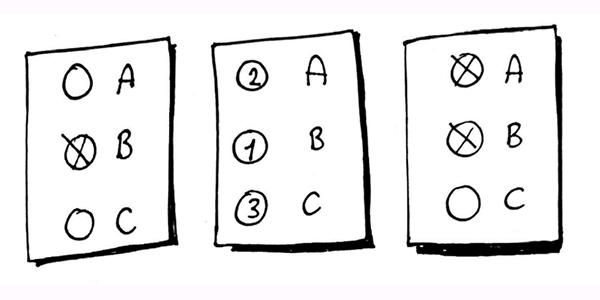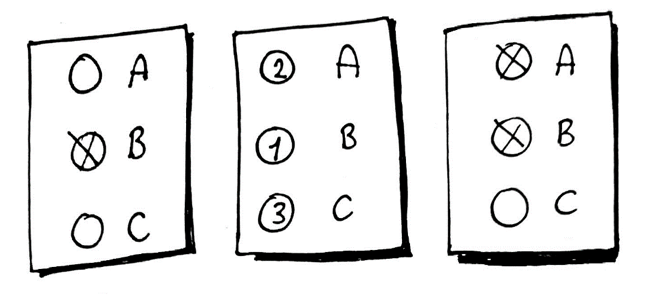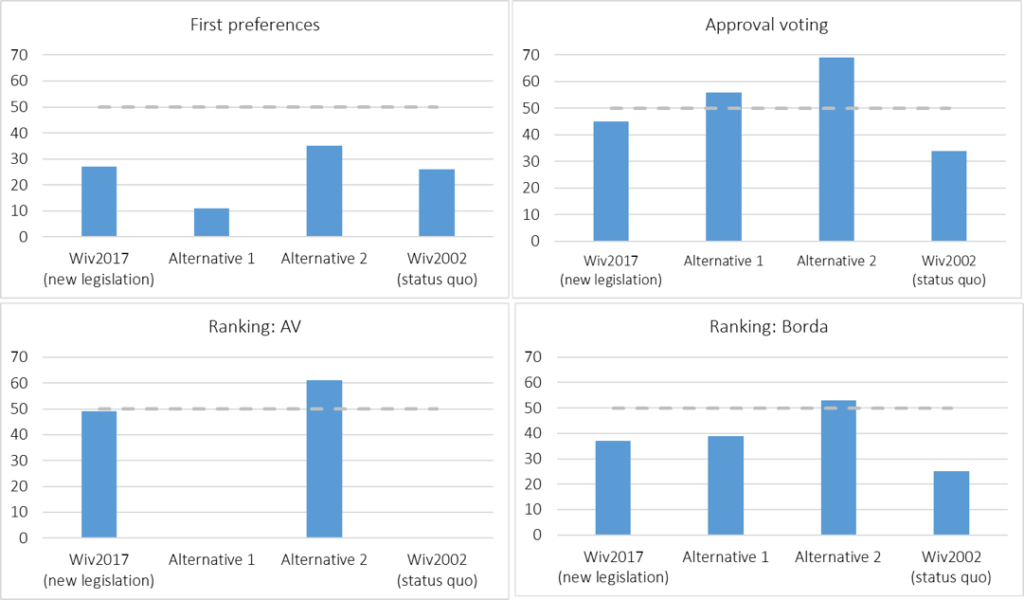Referendums can be more effective if voters can choose from several options
As the UK prepares for a second general election since the 2016 Brexit referendum, Charlotte C.L. Wagenaar demonstrates how a multi-option referendum could be a valuable tool in future to gauge more nuanced public attitudes on divisive issues. By presenting several alternatives, they can encourage votes for constructive compromises rather than blunt protest votes.

Referendums are often criticised for their bluntness. Voters can only vote ‘in favour’ or ‘against’ on a particular policy proposal: there is no room for compromise. This is especially problematic when a majority of voters reject the status quo. Such an outcome often requires significant interpretation and negotiation about what should replace the status quo, as the Brexit referendum nicely illustrates.
Yet there are ways to mitigate such an intricate referendum aftermath. In recent research I demonstrate using a voter survey how multi-option referendums can capture preferences in more detail and yield more constructive and workable outcomes by extending ballot choice to more than two options.
Additional ballot options
Extending ballot choice can counter the challenges that occur with binary referendum voting. Referendums often challenge a particular piece of legislation or status quo. Voters can express their rejection by voting ‘against’ (or to ‘leave’), options which are often rather blunt and broadly interpretable. Moreover, voters might interpret an ‘against’ option as a protest vote and use it to express their dissatisfaction with the current government or with politics in general.
Multi-option referendums offer voters more than one policy option on the same topic, usually by presenting multiple answer possibilities to a ballot question. They empower voters to express their preferences on more detailed policy scenarios. As a result, voters are more likely to vote constructively for one or more proposals that they support rather than accepting or rejecting one single proposal which they might only partially support.
Because multi-option ballot proposals are more detailed, voters can more accurately assess the policy implications of the different options. This also facilitates the interpretation of the outcome: rather than making educated guesses about what a majority intended with a rejection, majority support for an alternative policy proposal more clearly points towards the most-desired policy route. As such it eliminates the need to interpret underlying policy preferences using pre- or post-referendum polls or studies. For the Brexit referendum, different future UK-EU scenarios have been suggested in relation to the referendum in 2016 and a possible second referendum. Other examples would have been a Devolution Max option in the Scottish Independence referendum and a ballot featuring alternative electoral systems instead of just offering the Alternative Vote in the referendum in 2011.
Multi-option referendums could thus address the bluntness of binary referendum voting. This survey study tests this assumption by presenting voters with a multi-option design in the context of a binary referendum that resulted in a narrow rejection.
The challenge of majority support
A common argument against multi-option referendums is that it can be a challenge to reach an undisputed outcome. Whereas binary referendums always produce an absolute majority winner, this is not guaranteed when three or more options are on the ballot. Many multi-option referendum experiences around the world have demonstrated that plurality rules can elect disputed winners, often resulting in a neglected referendum outcome. Controversial outcomes can diminish or even undo the value of the referendum instrument.
Majoritarian democracies like the UK are familiar with plurality winners under single member district elections. However, the election of multiple MPs can compensate for disproportionality at least to some extent. Referendum voting, on the other hand, results in a single winner. The ‘winner takes all’ effect of a policy option winning by a plurality – and often minority – of votes is much larger.
To avoid such situations, one can use alternative voting methods. At least two options are available, namely ranking and approval voting.
Figure 1. The first preference voting method and its two alternatives (ranking and approval voting)

Give voters more votes
First, voters could rank the ballot options according to their preferences. Second, voters could mark any or all options that they consider acceptable. This gives voters a better opportunity to express their preferences for new policy and provides a clearer picture of the support for alternative policy routes. The more detailed and supported the referendum outcome, the more likely it is that policymakers can solve the issue to the satisfaction of a majority of citizens.
The survey study tested these voting methods in practice. It posed a hypothetical four-option referendum to a representative group of voters. The study was carried out in the context of an actual binary referendum taking place in March 2018 in the Netherlands. The referendum represented a prototypical example of the shortcomings of a binary vote. Parliament had approved new legislation on updated legislation on the security services, giving the services additional data collection powers. Under legislation valid at the time, 300,000 citizens could initiate a referendum on recently approved legislation.
In the resulting corrective referendum, voters could accept or reject the legislation. However, societal debate demonstrated that most voters did not fully oppose the legislation but felt that it required adaptation. This was later confirmed in a large-scale post-referendum study. Even the initiators of the citizen-initiated referendum were not against new legislation in principle, but considered privacy to be disproportionally jeopardised under the new law. Their desire for a compromise – adapted legislation – could not be expressed on the referendum ballot. The referendum resulted in a very narrow rejection of the new policy: 49.4% voted against and 46.5% in favour (the remainder cast blank votes, which are counted as valid votes in the Netherlands). The outcome was difficult for policymakers to interpret and act on.
Majorities under alternative voting methods
The survey study shadowed this binary referendum by simulating a four-option referendum on the new legislation and two adaptations of it. When casting only a first preference vote, 35% of respondents voted in favour of an alternative entailing adapted legislation (see Figure 2). Another question asked respondents to approve as many or as few options as they wished. In response to this question, 69% approved the same policy alternative.
When voters can rank the options, one can apply different methods to calculate an outcome. Under Alternative Vote, the least popular options is eliminated and its votes are transferred to its supporters’ second preferences. This redistribution process can be repeated for the next least-preferred option. This resulted in a 61% majority for the winning option. In another calculation, a variation on a modified Borda count was applied, in which a certain number of points was distributed over the options, depending on their ranks and on the number of options ranked by each respondent. This method resulted in a 53% majority for the adapted legislation.
Figure 2. Referendum outcomes under first preferences, approval voting and ranking

Conclusions for referendum design
The findings in the survey demonstrate that offering more detailed alternatives can work. The multi-option design provided convincing majority outcomes which were in line with the actual referendum outcome – i.e. rejecting the proposed legislation – as well as with societal debate – i.e. accepting the legislation with certain modifications.
The survey also shows that clear majorities can be produced when voters can assess each of the options rather than vote only for their most-favoured option. In the survey study, the same winner emerged with an absolute majority under different voting methods.
Future referendums in the UK and elsewhere could benefit from a multi-option design. Multi-option referendums empower voters by presenting them with a number of more detailed ballot options. When voters can express themselves on not one but multiple policy scenarios, this can result in clear majority outcomes. By capturing more detailed voter preferences, referendums can more effectively inform policymaking.
This article gives the views of the author, and not the position of Democratic Audit. It draws on the journal article ‘Beyond for or against? Multi-option alternatives to a corrective referendum’ in Electoral Studies.
About the author

Charlotte C.L. Wagenaar is a researcher at Tilburg University. She specialises in multi-option referendums and referendum design. Her research further focuses on citizen participation and election administration.





 Democratic Audit's core funding is provided by the Joseph Rowntree Charitable Trust. Additional funding is provided by the London School of Economics.
Democratic Audit's core funding is provided by the Joseph Rowntree Charitable Trust. Additional funding is provided by the London School of Economics.
This is a fantastic article and needs to be promoted extensively throughout the UK in our Parliaments desperate and pathetic rush to get a new Government and organise our departure from the EU with such a polarised setting. Let us hope that we can organise a strong second referendum that allows us to explain that if we want to remain in the EU, what we would like to change and if we want to leave what we want to achieve from our departure.